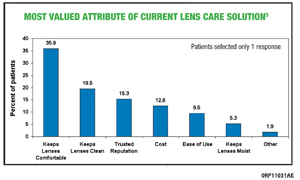All patients, both those new to contact lens wear and long-time wearers alike, need to be educated and re-educated about the importance of compliance. I suggest paying particular attention to new patients who have been wearing lenses fitted or dispensed elsewhere. These patients may have not been prescribed a particular solution or worse yet, been told that all solutions are interchangeable.
Long-time contact lens wearers are more likely to slip into bad habits, such as straying from the recommended cleaning regimen. These patients will often arbitrarily switch solutions to utilize coupons they clip or store brands, or simply use whatever their spouse picks up at the supermarket.
In our practice, all doctors ask a simple question: “Which solution are you using?” By asking an open-ended question, we learn quickly if patients are aware of the solutions they are using and whether they are paying attention to the label.
 If they cannot recall the exact name, we ask them to point it out from the samples we keep in the office. If they say “the green bottle,” I pull out a laminated brochure from Alcon that shows all the varieties of contact lens solutions available in green bottles and ask them to point out the one they are using. Finally, if the patient isn’t using OPTI-FREE® RepleniSH® Multi-Purpose Disinfecting Solution (MPDS), I take a minute to recommend this solution.
If they cannot recall the exact name, we ask them to point it out from the samples we keep in the office. If they say “the green bottle,” I pull out a laminated brochure from Alcon that shows all the varieties of contact lens solutions available in green bottles and ask them to point out the one they are using. Finally, if the patient isn’t using OPTI-FREE® RepleniSH® Multi-Purpose Disinfecting Solution (MPDS), I take a minute to recommend this solution.
OPTI-FREE® RepleniSH® MPDS has a proven track record for its disinfection efficacy,1 as well as its biocompatibility with silicone hydrogels.2 The reconditioning agents promote better end of day comfort—a common problem among contact lens wearers.3 When prescribing OPTI-FREE® RepleniSH® MPDS, I explain to patients that it will not only keep their lenses clean, but also enhance their lens wearing experience.4
The issue with patients switching solutions on their own is addressing problems if they arise. It is easy for the doctor to assume that the lens itself is the culprit unless the practitioner asks whether the patient has switched solutions.
Because all contact lens solutions are formulated differently, switching solutions can result in biocompatibility problems. With store brand or generic solutions, the actual formula may change while the name and the packaging remains the same.
So, to reinforce the message, I recommend taking a few minutes at the end of each visit to educate patients about “look alike” products explaining that they are not the same as the solution I prescribe.
1. Rosenthal RA, Henry CL, Buck SL, et al. Extreme testing of contact lens disinfecting products. Contact Lens Spectrum. 2002 Jul.
2. Andrasko G, Ryen K. Corneal staining and comfort observed with various contact lens and solution combinations. Poster presented at Asia ARVO 2007.
3. Stiegemeier M, Friederichs G, Hughes J, Larsen S, Movic W, Potter W. Clinical evaluation of a new multi-purpose disinfecting solution in symptomatic contact lens wearers. Contact Lens Anterior Eye. 2006 Jul;29(3):143-51.
4. Brujic M, Kading DL. The science of contact lens care. Contact Lens Spectrum. 2009 Aug.
5. Miller J, Powell S, et al. Solution Recommendations for Soft Contact Lens Wearers. Poster presented at AOA. June 2010. Orlando, Fla.


